The Federal Energy Management Program (FEMP) presented its annual FEDS Spotlight recognition ceremony on August 23, 2019, at the 2019 Energy Exchange in Denver, Colorado. The program provided an opportunity for agencies to shine a spotlight on their federal employees working to implement programs and projects that cut energy waste, reduce costs, optimize performance, and advance America’s progress toward energy independence, resilience, and security, while also enabling more effective accomplishments of federal agencies’ missions.
Congratulations to the 2019 FEDS Spotlight honorees!
Download high resolution photos of the honorees.
2019 FEDS Spotlight Honorees

Cynthia Vallina
Office of Management and BudgetDuring her 30 years of federal service, Cyndi Vallina has promoted the effective pursuit of sustainability goals across the federal enterprise. By contributing to the development of government-wide measures and guidance across six presidential administrations, providing direction to agencies as they work toward goals, and applying her expertise to hold agencies accountable for progress, she helps catalyze federal investments, expand the use of advanced and emerging technologies, and save taxpayer dollars across more than 25 agencies.

Juan Griego Jr., Ky Nguyen-Zubroski, and Kenneth Shutika
Greater Southwest Region 7In June 2018, the General Services Administration (GSA) Region 7 completed reverse auctions for GSA-owned facilities in Texas, awarding two contracts that cover 99 electricity accounts with a combined electricity usage of more than 498 million kWh over the 60-month contract term. The new contract rates per kWh will result in savings of $1.65 million each year and $8.23 million over the contract term for a savings of 29.3%. The new contracts also bring Region 7’s renewable electricity up to 100% from only 50% in the previous contracts.

Nicholas Murdock
Kennedy Space CenterNicholas Murdock led a multidiscipline team to successfully develop an enhanced-use lease agreement that enabled the National Aeronautics and Space Administration’s (NASA) Kennedy Space Center (KSC) to host a Florida Power and Light 74.5 MW utility-scale solar photovoltaic system expansion, significantly assisting NASA in meeting its renewable energy goals. He is also leading the development of a utility energy service contract that, once implemented, will avoid about $1.8 million in annual KSC expenditures.
Lara Buluç
U.S. Forest ServiceLara Buluç serves as the project manager of the U.S. Department of Agriculture’s first off-grid Energy Savings Performance Contract ENABLE project, which will increase the resilience of mission-critical fire stations at five national forests and save about $136,000 and 3 billion Btu per year. She also spearheaded an agency-wide payment collection pathway for workplace electric vehicle charging, which paved the way for increased charging station use by employees and the public.
Kelly Jaramillo
U.S. Forest ServiceKelly Jaramillo mobilized a network for forest-level, sustainable-operations staff with engagement tools that include a region-wide microgrant program to provide seed funding for advancing energy and water efficiency projects, asset priority index workshops that help integrate energy management considerations into facility planning, and a strategic energy audit program. She also helped streamline a national database that supports and tracks agency-wide sustainable operations.

Will Freeman
National Weather ServiceAs part of his ongoing efforts to achieve a better balance between equipment performance, costs, and energy consumption, Will Freeman led a National Weather Service (NWS) program to replace inefficient heating, ventilation, and air conditioning systems with right-sized, more-efficient systems. Once all identified replacements are complete, NWS will realize annual energy cost savings of $8,700 per unit and more than $10 million in total energy cost savings.
Roxanne Fuhrman
U.S. Patent and Trademark OfficeWhile managing the U.S. Patent and Trademark Office’s Environmental Compliance and Sustainability Program, Roxanne Fuhrman continuously strives to further decrease energy consumption throughout the 2.5-million-square-foot, energy-efficient campus. Recently, she conducted systematic lighting replacements of traditional bulbs to LED, which decreased energy use intensity by 13%. She has also directed the increase in renewable electricity use by 16%.
Timothy Hoseth
Office of the General CounselTimothy Hoseth provided exceptional legal and transactional advice to U.S. Department of Commerce operating units, resulting in the award of three ESPCs over the past two years, which are valued at almost $56 million. The projects include an 8 MW combined heat and power plant project and a 15-acre solar cell field installation at the National Institute for Standards and Technology’s Gaithersburg, Maryland, campus.
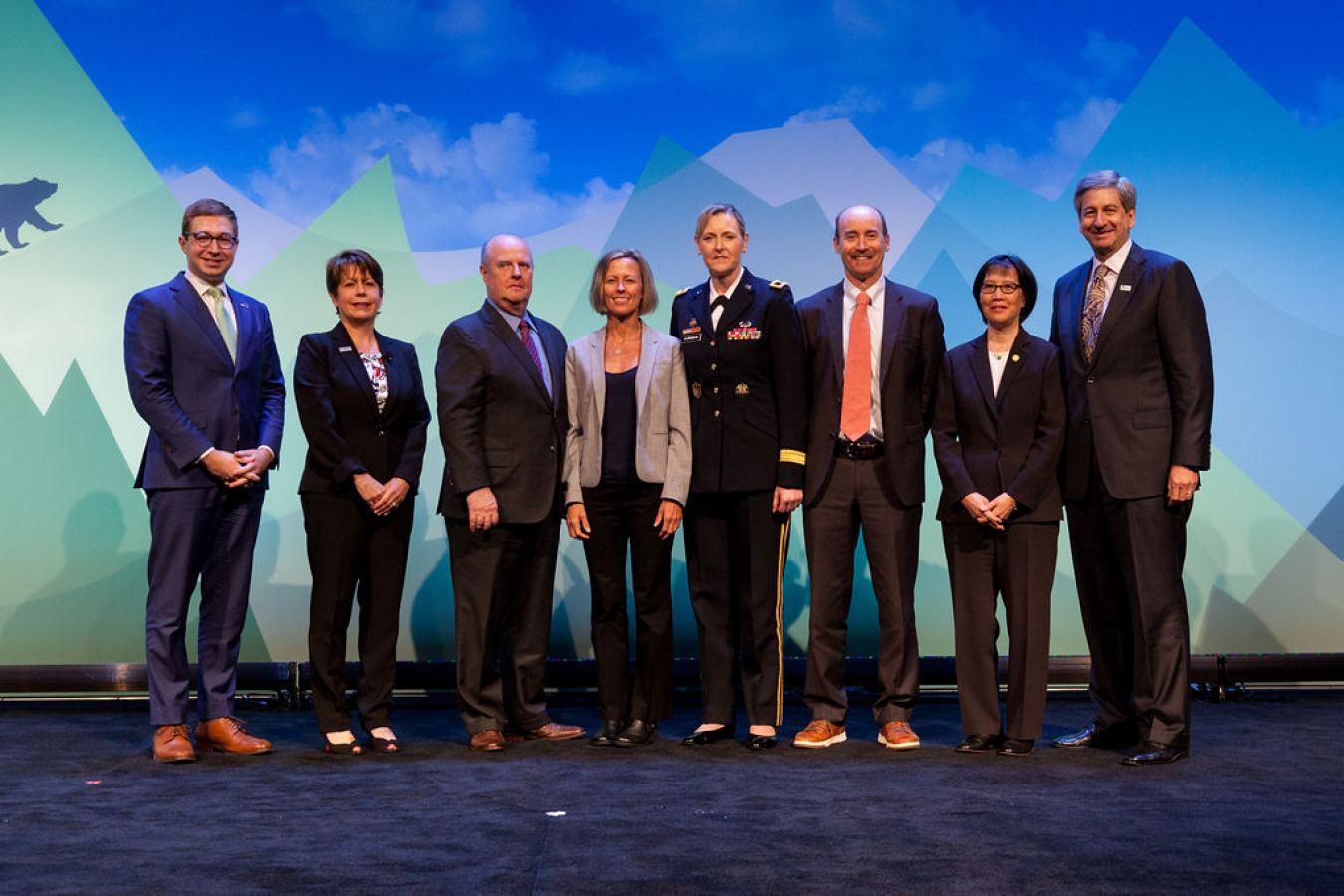
Tim Tetreault
Office of the Assistant Secretary of Defense for SustainmentTim Tetreault has worked closely with internal stakeholders, federal staff, and industry representatives to get new energy technologies demonstrated and transitioned into full use at DoD installations worldwide through appropriated and performance contracting projects. His ability to leverage the intellectual capital and technical solutions of DoD’s industry partners has closed energy gaps and strengthened DoD’s energy resilience posture.
Sarah Mandes, Department of the Army
Douglas Tucker, Department of the Air ForceAs members of DoD’s planning teams for the 2019 Energy Exchange, Sarah Mandes and Doug Tucker collaborated with senior leaders and stakeholders to ensure critical DoD energy policies and priorities were incorporated into the event program and training sessions. Their forward-thinking approaches helped to enhance energy professionals’ skillsets for implementing Executive Order 13834 and energy resilience solutions to improve mission assurance at DoD and across the federal government.
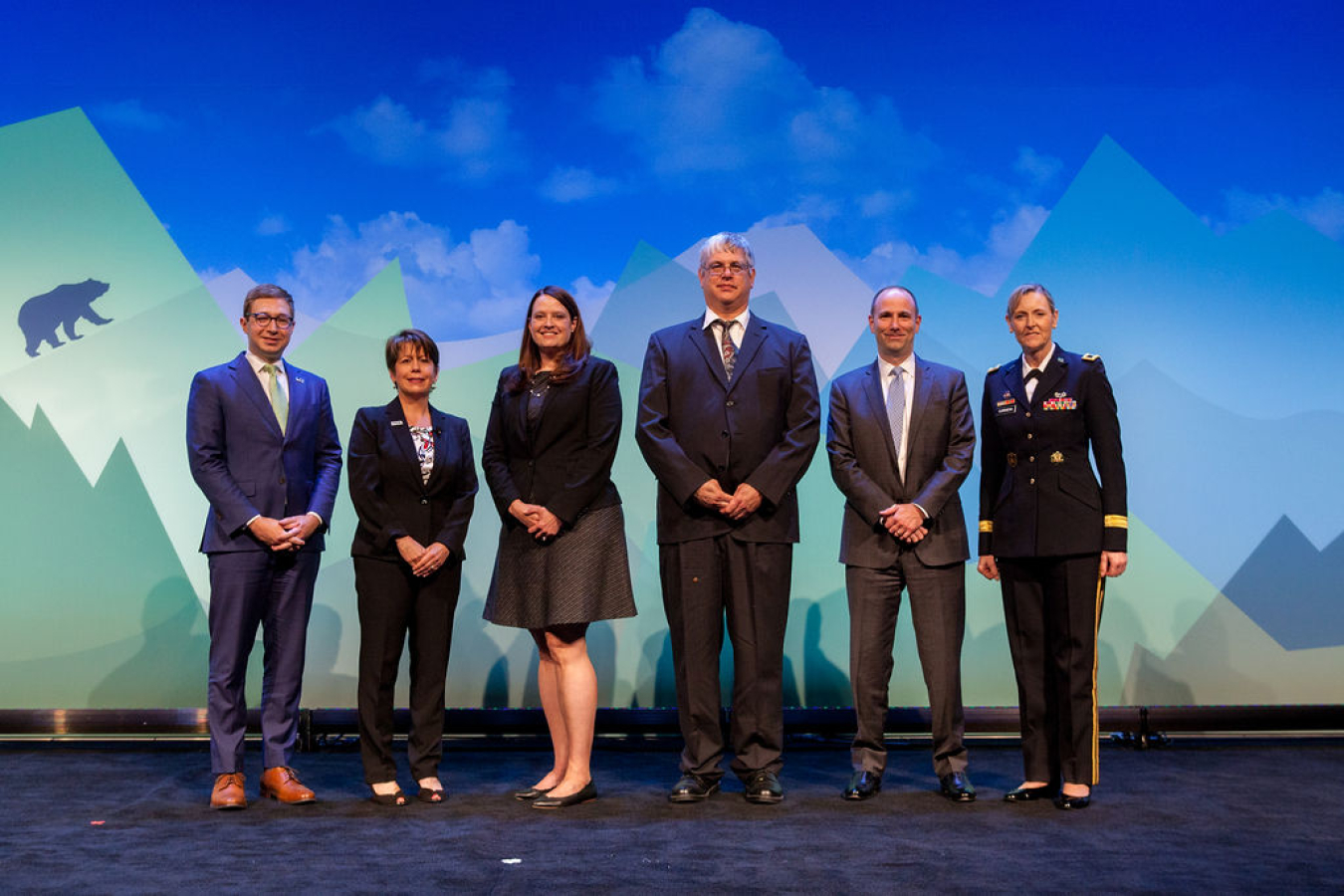
Denise Faldowski
Office of the Assistant Chief of Staff for Installation ManagementDenise Faldowski was critical in developing the Army’s energy and water security pivot to resilience to ensure that critical assets are mission-ready across installations. She coordinated across services and key Army stakeholders to develop substantive metrics and the Army’s holistic Installation Energy and Water Plan Guidance, which will enable the Army to continually evolve and evaluate the impacts of energy and water security on installations for years to come.
Derek Miller
U.S. Army Garrison Kwajalein AtollDerek Miller is partnering with industry to implement an ESPC at U.S. Army Garrison Kwajalein Atoll that includes innovative large-scale cooling and renewable energy systems, as well as traditional energy conservation measures. Once complete, these projects will reduce the installation’s reliance on diesel fuel by more than 50% while significantly improving power reliability and enhancing on-site resiliency and mission readiness.
Douglas Van Werden
Rock Island ArsenalDouglas Van Werden coordinated with the local utility and key personnel to install two backup generators that provide about 25% of Rock Island Arsenal’s critical energy requirement. When paired with the local curtailing program, this effort will generate $200,000 in annual credit to the electric bill. He also spearheaded projects to replace natural gas supply lines, change a central steam plant to dedicated boilers, and convert more than 4,600 lighting fixtures to LED.
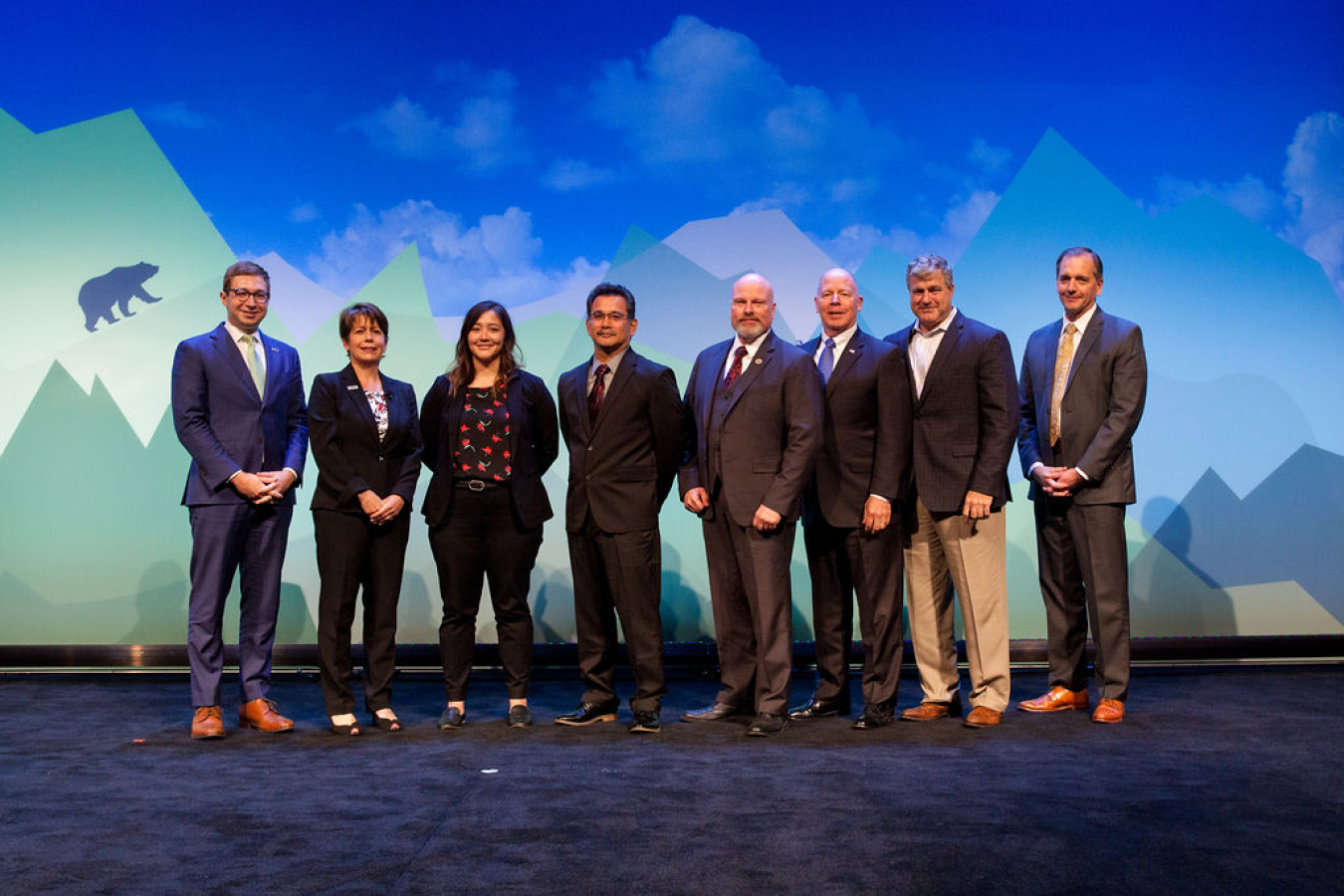
Anthony Mesa
Marine Corps Logistics Base BarstowInstallation Energy Manager Tony Mesa led his team at Marine Corps Logistics Base (MCLB) Barstow to award a $10.7 million, 22-year ESPC. Bundling long-term payback actions with short-term measures, the project will improve upon previous MCLB Barstow energy efficiency initiatives and renewable energy projects to help build energy resilience and develop a comprehensive and integrated energy plan.
Amanda Renjifo
Marine Corps Base Camp LejeuneAmanda Renjifo, Installation Energy Manager for Marine Corps Base Camp Lejeune, is coordinating the award of a $150 million, three-phase utility energy services contract. The contract will finance infrastructure upgrades and other energy resilience measures using savings generated by traditional energy conservation measures and the automation of water and wastewater operations and maintenance processes. She plans to use the modernized infrastructure as a pathway to create multiple microgrids for the military complex.
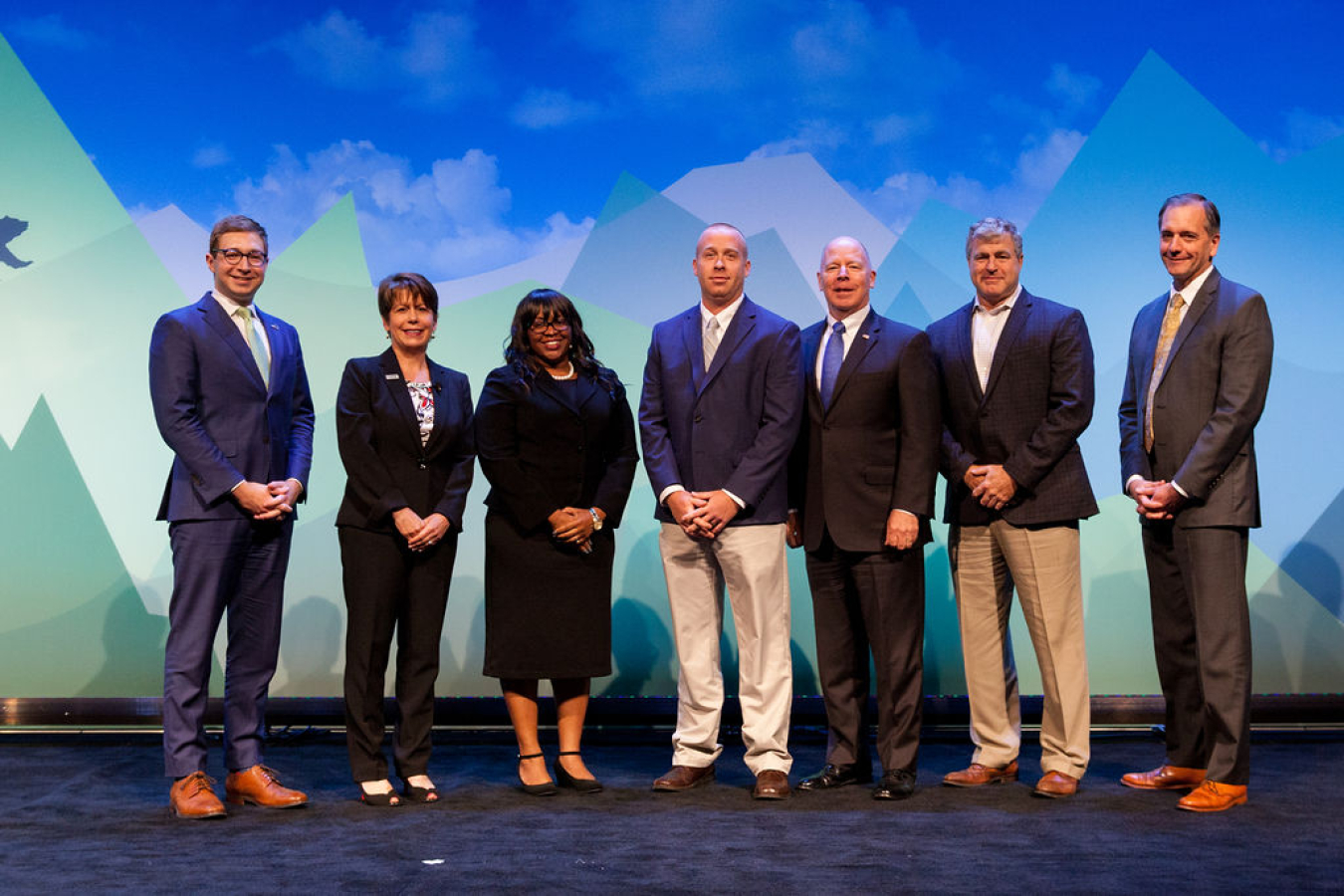
Bernard Lindsey
Navy Region SouthwestBernard Lindsey serves as regional energy program manager and provides management oversight for 10 installation energy managers across Navy Region Southwest. His leadership during the rollout of the Navy’s Energy Security Assessment Tool ensured the smooth implementation of the Energy Management Integration Group and the Installation Energy Plans. He also acted as technical advisor to eight regional commanders on energy program issues related to shore infrastructure planning and programming requirements.
Eric Speight
Naval Facilities Command AtlanticEric Speight spearheaded the successful implementation of the Navy’s Smart Grid Pilot at Field Engineering Command Mid-Atlantic. Smart Grid is a centralized monitoring and control system that analyses building energy, system performance, and utility data to generate actionable information. Energy use data is now available in near real time and helps the Navy reduce utility costs and recovery times from cyber attacks and outages.
Sabrina Williams
Navy Region SoutheastServing as installation energy manager for Naval Air Station Pensacola, Florida, Sabrina Williams has executed a robust and well-managed energy program that utilizes all available resources, programs, and acquisition strategies that include multiple UESCs and numerous locally generated energy improvement projects. Under her direction the installation has reduced its energy intensity by almost 13% from the fiscal year (FY) 2015 baseline and its water intensity by more than 44% from the FY 2007 baseline.
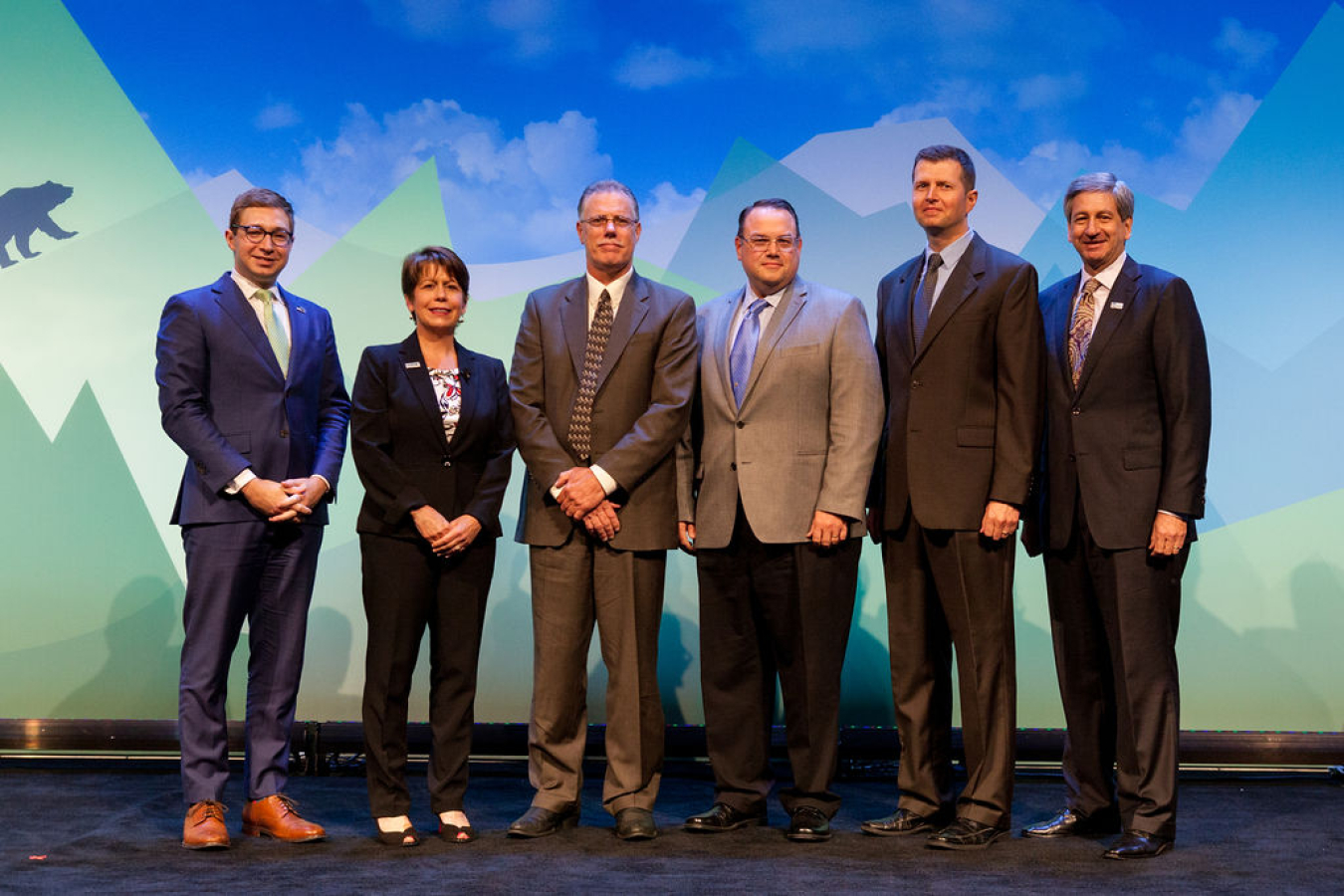
Dave Fort, John Stickney, and Steve Wolpert
Air Force Materiel CommandRepresented by Dave Fort, John Stickney, and Steve Wolpert, the Air Force Installation and Mission Support Center Detachment 6 Energy Team developed and operationalized a holistic, inclusive, and mission-centric approach to direct the Air Force Materiel Command (AFMC) in addressing energy assurance, which culminated in the AFMC Energy Assurance Campaign Plan. Through the Energy Assurance Working Group, the team continues to assure top-to-bottom strategic alignment, while retaining an AFMC mission-centric approach.

John Nelson
DLA EnergyThrough his work on U.S. Department of Defense (DoD) planning teams for the 2019 Energy Exchange, John Nelson helped to ensure that the event program and training sessions were directly tied to the DoD’s energy priorities and provided valuable training for DoD’s energy professionals who attended the event. His forward-thinking approaches helped enhance energy professionals’ skillsets for implementing Executive Order 13834 and energy resilience solutions to improve mission assurance at DoD and across the federal government.
Jacob Vigil
DLA EnergyAs a contracting officer for DLA Energy, Jacob Vigil has successfully executed more than $940 million in ESPC awards during the past year for Air Force installations located in the United States, Japan, and South Korea. Combined, these efforts support $441 million in third-party investments in facility energy and water improvements that are projected to save more than 901 billion Btu of energy and 13 million gallons of water annually.

Levi Gabre
Strategic Petroleum ReserveLevi Gabre led a multiyear effort at the U.S. Department of Energy’s (DOE) Strategic Petroleum Reserve Bill Hill Site to replace more than 100 480 V, high-pressure sodium lights with comparable LED lights of various sizes, lumens, and voltages. This project resulted in reductions in electricity and cost savings of almost 509,000 kWh and $46,000, respectively, since the project start in 2012, as well as more than $184,000 in reduced maintenance labor costs due to the longer LED bulb life.
Jennifer Hollenbeck
Bonneville Power AdministrationDuring the last year, Jennifer Hollenbeck spearheaded and tracked 25 energy efficiency projects across Bonneville Power Administration’s service territory, accounting for estimated energy savings of more than 1.3 million kWh over the lifetime of the projects and cost savings of more than $91,000 each year. She secured more than $333,000 in incentives to help fund these projects. She also co-authored a utility management strategy that allows for better and more responsive intra-agency collaboration in service of energy and sustainability goals.
Teresa Perkins
DOE-Idaho Operations OfficeAs director of the Environmental Support Division for the DOE-Idaho Operations Office, Teresa Perkins has provided outstanding leadership to institute a positive, effective, and enduring sustainability culture. Ensuring that sustainable priorities were incorporated into project and program planning efforts, Teresa’s work has resulted in outstanding goal performance at Idaho National Laboratory, which included reductions of 18.4% in site energy intensity since fiscal year (FY) 2003 and 22% in water intensity since FY 2007.
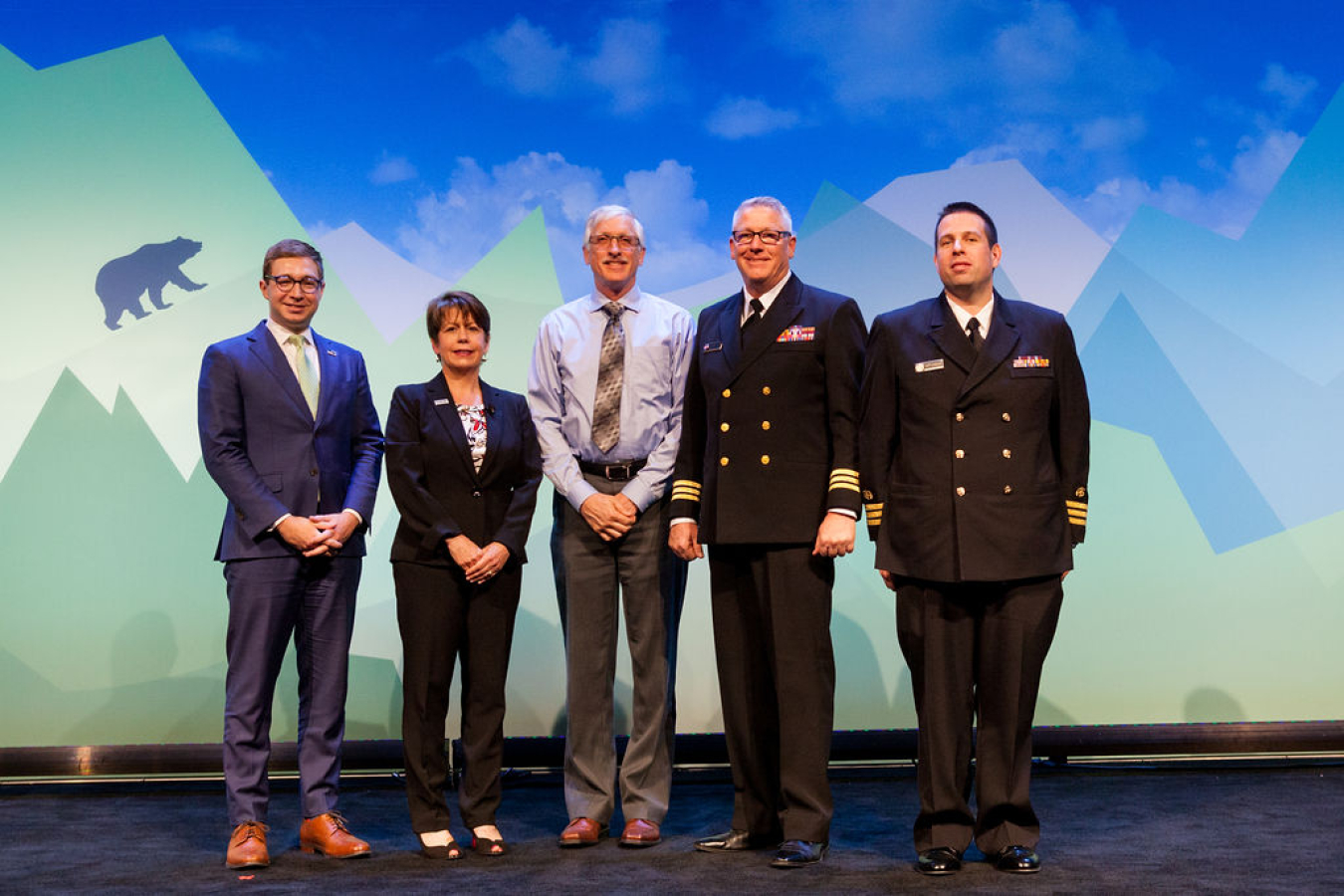
CDR Chris Guess, CDR Harry Turtschanow, and Monica Weaver
Indian Health ServiceCDR Chris Guess, CDR Harry Turtschanow, and Monica Weaver executed the first UESC in Indian Health Service’s history at the Phoenix Indian Medical Center in Phoenix, Arizona. The project installed boiler and heating, ventilation, and air conditioning improvements; lighting and water system upgrades; and a 250 kWh photovoltaic system. The first phase resulted in savings of 9.4 billion Btu and $282,000 annually and reductions in net usage of 24% in grid electricity, 50% in water, and 3% in natural gas.
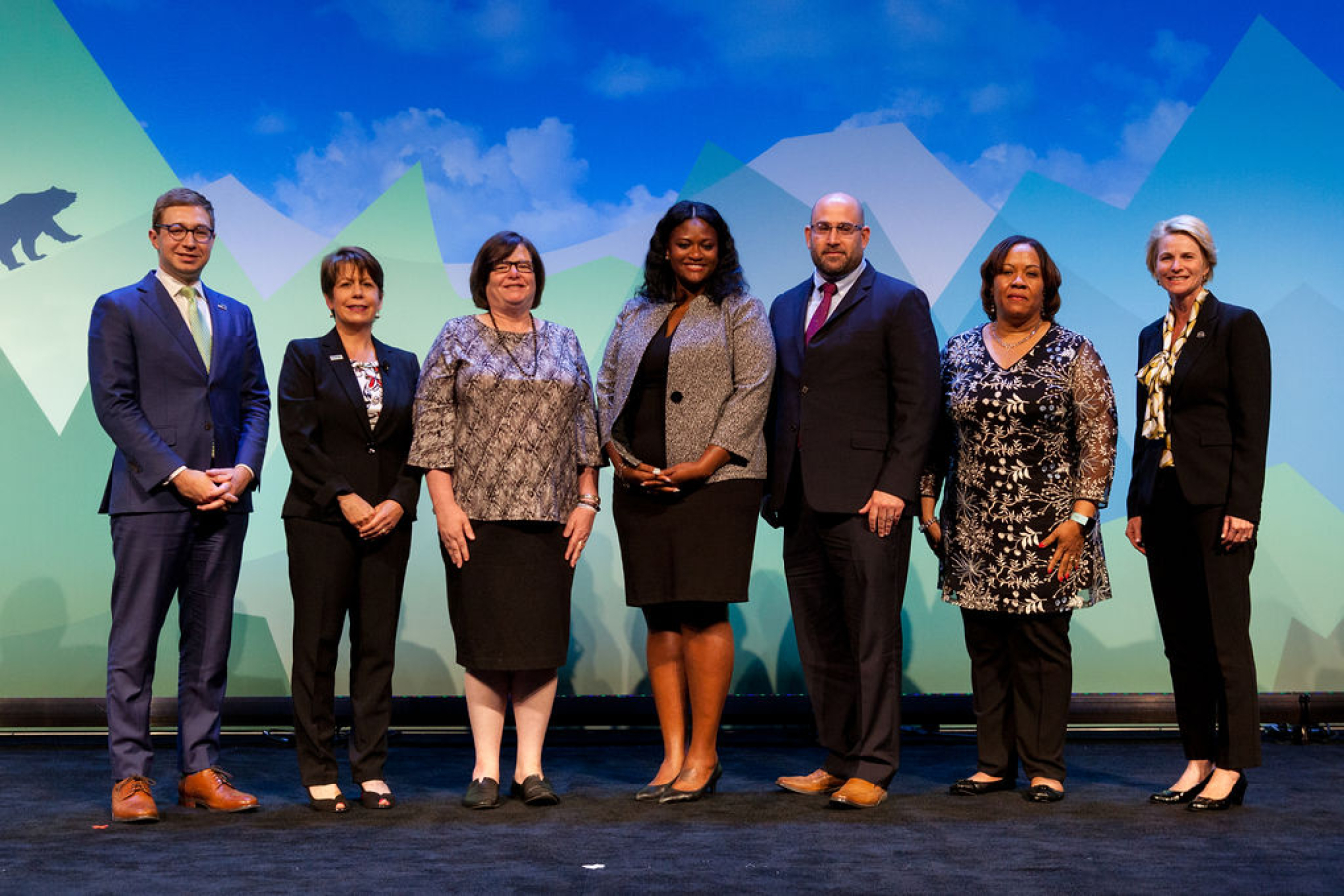
Ashley Harrigan
Office of Operations/ContinuityAshley Harrigan has been instrumental in supporting the Resilience Framework Tiger Team (RFTT) and formalizing the Critical Infrastructure Security and Resilience (CISR) working group. As part of her role, she coordinated the collaborative integration of resilience within the RFTT and CISR working group, and incorporated tools developed by the Federal Emergency Management Agency and Cybersecurity Infrastructure Security Agency into the Department of Homeland Security’s (DHS) best practices.
Kelly Lease
Customs and Border ProtectionAs a member of the RFTT representing the Customs and Border Protection Component, Kelly Lease brought her team of experts into a group dedicated to DHS’ four focus areas: energy and water, facilities, information and communication technology, and transportation. Under her leadership, the team worked hard to develop solutions and improve processes that resulted in the Resilience Baseline Assessment Scoring Tool, a product DHS can use to implement innovative, cost-effective projects supporting resilience.
Michael Scarola
Office of Operations/ContinuityAs branch chief for mission assurance, Michael Scarola spearheads the exchange of technical expertise for the DHS’ resilience effort at the national level. His leadership was instrumental in developing the RFTT and formalizing the CISR working group. His management and expertise in developing resilience policy and resource planning guidance has helped bring these efforts to the forefront as a priority to the teams and the Secretary of Homeland Security.

Thomas Budinger
Federal Bureau of InvestigationThomas Budinger planned and launched the Federal Bureau of Investigation’s (FBI) Electric Vehicle (EV) Charging Station Initiative, establishing a framework for installing EV charging stations for privately owned vehicles. He gathered data on EV ownership and use to identify high-demand locations and inform facility managers about the number of charging stations to install. He also founded an FBI EV charging station community of practice to support the sharing of best practices and lessons learned among FBI facility managers nationwide.
Andrea Thi
Justice Management DivisionAs the Department of Justice’s (DOJ) sustainability and environmental program manager, Andrea Thi has provided outstanding leadership to ensure continued improvement in DOJ’s sustainable performance. In FY 2018, she improved communication and introduced a higher degree of agency-wide accountability through new initiatives that included the development of bureau-level scorecards and a new tracking and reporting tool that facilitates the collection and update of bureau-level project data.
Jeff Verhulst
Federal Bureau of PrisonsJeff Verhulst managed six ESPCs in FY 2018 for the Federal Bureau of Prisons’ North Central Region. The contracts have a combined implementation value of more than $55 million, and the projects are estimated to save more than 131.7 billion Btu and more than 101 million gallons of water annually. He also worked with colleagues to complete seven directly funded energy projects with a combined investment of $1.8 million that will result in energy savings of more than 32 million and annual cost savings of $360,000.

Doug Berry
Veteran Integrated Service Network 12Doug Berry serves as a contracting officer’s representative and is responsible for project coordination of a large-scale ESPC for the Veteran Integrated Service Network (VISN) 12 region, which includes six medical center campuses across two states. He has been instrumental in managing the complexities of the $87.9 million contract, keeping the projects on track to save approximately $5.3 million in energy and water costs annually, which will avoid $165 million in costs over the 20-year term for the six facilities.
Steve Bolewski
Veteran Integrated Service Network 2As the VISN 2 region energy manager, Steve Bolewski provides key support on four performance contracts with a combined implementation value of more than $120 million, which are expected to save more than $7.5 million annually. He facilitates communication with leadership, offers technical expertise, and helps facility engineers find optimal solutions to save energy, increase resiliency, and ensure the facilities can effectively care for our veterans.
Craig Hansen
Veteran Integrated Service Network 15Craig Hansen serves as the contracting officer’s representative for a two-phased ESPC for the VISN 15 region, which is valued at almost $56 million. By gaining support to share savings across nine medical center campuses, he helped the project maximize benefits and incorporate several priority measures that otherwise would not have been economically viable. Once both phases are complete, the project is expected save more than $3 million in annual energy and water costs.

